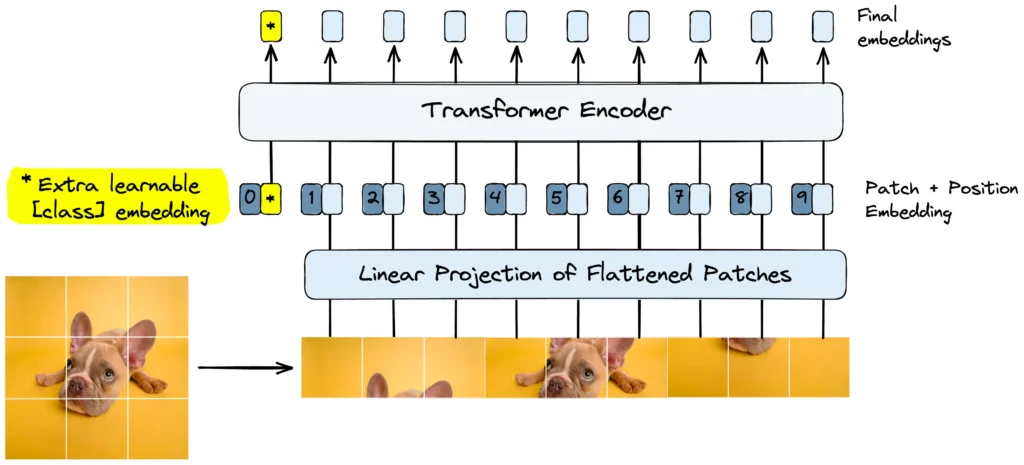Autoencoder is a type of neural network architecture designed for unsupervised learning which excel in dimensionality reduction, feature learning, and generative modeling realms. This article provides an in-depth exploration of autoencoders, their architecture, types, applications, and implications for NLP and machine learning.
Understanding Autoencoders
Definition
Autoencoders are unsupervised neural networks that learn to encode input data into a compressed, low-dimensional representation and then decode it back into the original data. The core idea is to minimize the difference between the input and the reconstructed output, forcing the network to learn meaningful representations.
Architecture
- Encoder: This part takes the input data and compresses it into a lower-dimensional space known as the “latent space” or “bottleneck.” The encoder usually comprises a series of neural layers that progressively reduce the dimensions of the input data.
- Latent Space: This is the compressed representation of the input data produced by the encoder. It holds the most significant features required to reconstruct the input. The characteristics of the latent space are crucial, as they determine the quality of reconstruction and the ability of the autoencoder to generalize from the training data.
- Decoder: he decoder takes the compressed representation from the latent space and reconstructs it back into the original input space. It also has a series of layers, often symmetric to the encoder layers, that amplify the compressed representation back to the input space.

Loss Function
The primary objective of an autoencoder is to minimize the reconstruction error, which measures how closely the output of the decoder matches the original input. The most common loss function used is Mean Squared Error (MSE), although other metrics like Binary Crossentropy might be applied depending on the nature of the input data (e.g., binary data).
Mathematically, the reconstruction loss can be expressed as:
\[
L = \frac{1}{n} \sum_{i=1}^{n} || x_i – \hat{x}_i ||^2
\]
where \( x_i \) represents the original input, \( \hat{x}_i \) is the reconstructed output, and \( n \) is the number of input samples.
Types of Autoencoders
- Vanilla Autoencoder: The most basic form, a vanilla autoencoder, is typically a feedforward neural network that performs basic encoding and decoding without any additional mechanisms. It is susceptible to overfitting, especially with high-dimensional data.
- Denoising Autoencoder: Denoising autoencoders are designed to learn robust representations of the data by training on corrupted inputs. They randomly corrupt a fraction of the input data and teach the model to reconstruct the original data. This strategy helps the model generalize better and is particularly useful in NLP tasks where noise often infiltrates the data.
- Variational Autoencoder (VAE): Variational Autoencoders incorporate probabilistic elements into their architecture. Instead of learning a fixed compression of the data, VAEs learn to encode inputs into distributions in the latent space. This allows for generating new data points and introduces a unique structure to encode uncertainty.
- Convolutional Autoencoder: When dealing with image data, convolutional autoencoders are particularly effective. They employ convolutional layers in the encoder and decoder, leveraging spatial hierarchies in the data.
- Sparse Autoencoder: Sparse autoencoders impose a sparsity constraint on the hidden units of the encoder allowing the network to learn more informative features by focusing only on a small number of active neurons at a time. This approach can enhance feature extraction, leading to more robust representations.
- Contractive Autoencoder: This variant discourages dependencies between encoded features by adding a regularization term that penalizes the model’s sensitivity to input perturbations. It promotes a more generalized representation of the input data, enhancing the robustness of the autoencoder.
- Sequence-to-Sequence Autoencoder: This type of autoencoder is designed to handle sequential data, such as text or time series. It encodes the input sequence into a fixed-size representation and then decodes it back into the original sequence.
- Adversarial Autoencoder: Adversarial autoencoders combine the principles of autoencoders with generative adversarial networks (GANs). They consist of an encoder, a decoder, and a discriminator, allowing the model to learn a more robust latent representation.
Training Autoencoders
The training process of an autoencoder involves the following steps:
- Data Preparation: Collecting and preprocessing the dataset, which may involve tokenization, normalization, and splitting into training and testing sets.
- Model Initialization: Setting up the neural network architecture, including determining the number of layers, type of activation functions, and latent space dimensionality.
- Forward Pass: Feeding an input vector through the encoder to obtain the latent representation, which is further processed by the decoder to generate an output vector.
- Loss Calculation: Computing the reconstruction loss using the chosen loss function.
- Backpropagation: Updating network weights using gradient descent optimization algorithms (like Adam or RMSprop) to minimize the reconstruction loss.
- Iterative Training: Repeating the forward and backward pass for multiple epochs until the model converges to a satisfactory performance level.
Applications of Autoencoders
- Dimensionality Reduction: Autoencoders can effectively reduce the dimensionality of data while preserving relevant structures. This capability makes them a prime choice for preprocessing data before feeding it into supervised learning models.
- Anomaly Detection: By learning the distribution of normal data, autoencoders can enhance anomaly detection capabilities. Any significant deviation from the reconstructed data can be flagged as an anomaly, applicable in fraud detection and network security.
- Image Denoising: In image processing, autoencoders can remove noise from images by training on noisy examples. The network learns to reconstruct clean images, making this approach valuable in various applications.
More applications…
- Natural Language Processing: In NLP tasks, autoencoders can be employed for:
- Text Representation: They serve as feature extractors to generate dense representations of text data, aiding in semantics.
- Sentiment Analysis: By reconstructing input text with an emphasis on semantic features, autoencoders enhance sentiment analysis models.
- Text Generation: Variational Autoencoders can be utilized for generating new text by sampling from the latent space.
- Recommendation Systems: Autoencoders can power recommendation systems by encoding user-item interactions and generating personalized recommendations based on learned representations.
- Collaborative Filtering: Autoencoders are applicable in collaborative filtering, where they can predict missing values in user-item interaction matrices. This assists in improving recommendation quality by learning user preferences accurately.
- Sequence-to-Sequence Learning: Autoencoders can be used for sequence-to-sequence learning tasks, such as machine translation and summarization, by encoding the input sequence and decoding it into the target sequence.
- Speech Recognition: Autoencoders can be applied in speech recognition tasks to learn acoustic features from audio signals, aiding in speech-to-text conversion and speaker identification.
- Time Series Forecasting: In time series forecasting, autoencoders can capture temporal dependencies in the data and generate predictions based on learned patterns.
- Generative Modeling: Autoencoders can be used for generative modeling tasks, such as image generation, by learning to generate new samples from the latent space.
Example: Building a Basic Autoencoder
To solidify our understanding of autoencoders, let’s walk through a simple implementation using a popular deep learning library, TensorFlow, in Python.
import numpy as np
import tensorflow as tf
from tensorflow import keras
from tensorflow.keras import layers
# Define an input dimension
input_dim = 784 # E.g., 28x28 images from MNIST dataset
# Building the Autoencoder model
input_layer = layers.Input(shape=(input_dim,))
encoder = layers.Dense(256, activation='relu')(input_layer)
encoder = layers.Dense(128, activation='relu')(encoder) # Provided bottleneck
decoder = layers.Dense(256, activation='relu')(encoder)
decoder = layers.Dense(input_dim, activation='sigmoid')(decoder)
# Combining the encoder and decoder creates the autoencoder
autoencoder = keras.Model(input_layer, decoder)
# Compile the autoencoder with an optimizer and loss function
autoencoder.compile(optimizer='adam', loss='binary_crossentropy')
# Sample training data from the MNIST dataset
(x_train, _), (x_test, _) = keras.datasets.mnist.load_data()
x_train = x_train.astype('float32') / 255.0 # Normalize pixel values
x_train = x_train.reshape((len(x_train), input_dim)) # Flatten images
x_test = x_test.astype('float32') / 255.0
x_test = x_test.reshape((len(x_test), input_dim))
# Train the autoencoder
autoencoder.fit(x_train, x_train, epochs=50, batch_size=256, shuffle=True, validation_data=(x_test, x_test))
# Use the encoder part to encode input data
encoder_model = keras.Model(input_layer, encoder) # Extract encoder model
encoded_data = encoder_model.predict(x_test) # Perform encoding on test dataIn this code, we create a simple autoencoder that learns to compress and reconstruct the MNIST dataset (consisting of handwritten digits). By structuring input data through dense layers, we relax dimensionality at the bottleneck layer and subsequently regenerate the original data.
Advantages of Autoencoders
- Unsupervised Learning: They can learn from unlabeled data, which is abundantly available in many of today’s applications.
- Feature Learning: Autoencoders excel at learning useful feature representations, which can be exceptionally beneficial for downstream tasks.
- Flexibility: They can be designed in various forms to cater to specific needs, allowing for customization in architecture and loss functions.
- Robustness: Their ability to impute missing values and denoise inputs lends a level of robustness, making them suitable for real-world applications.
Limitations and Challenges
While autoencoders offer many advantages, certain challenges exist:
- Overfitting: High-capacity autoencoders can memorize the training data rather than generalizing. Techniques like dropout, weight regularization, and the use of bias terms can help mitigate this issue.
- Training Complexity: The optimization process can be sensitive to hyperparameter choices, making training complex and requiring experimentation.
- Interpretability: Understanding the workings of latent representations can be difficult, leading to transparency concerns in applications like healthcare and finance.
- Loss of Information: In certain instances, the compression might strip away critical information, leading to poor reconstructions.
- Data Quality: Autoencoders are sensitive to the quality of data. Noisy or poorly curated datasets can hinder the model’s ability to learn meaningful representations.
Conclusion
Autoencoders are powerful tools in the machine learning toolkit, enabling various applications from dimensionality reduction to anomaly detection and many facets of NLP. They hold the potential to empower a myriad of applications, including representation learning, anomaly detection, and generative modeling.



